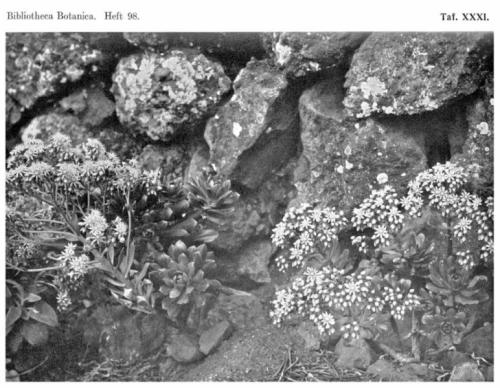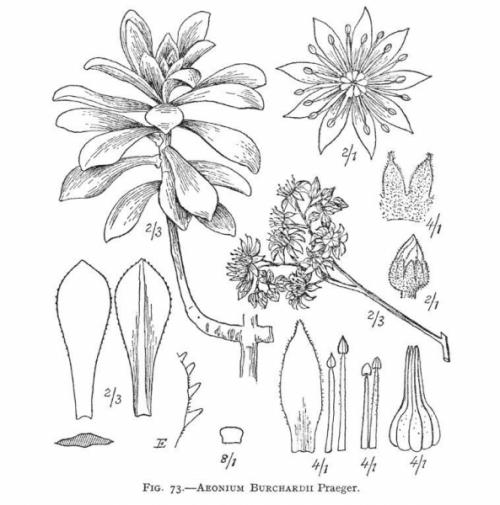x burchardii (Praeger) Praeger, 1929
Par: Aeonium pseudourbicum Bañares × Aeonium sedifolium (Bolle) Pit. & Proust
[Or Aeonium sedifolium (Bolle) Pit. & Proust × Aeonium urbicum (Hornem.) Webb & Berthel. when pseudourbicum is included in urbicum.]
Sempervivum ×burchardii Praeger, Notes on Canarian and Madeiran Semperviva, Transactions of the Botanical Society of Edinburgh 29: 202. 1925 (pro sp.).
Aeonium ×burchardii (Praeger) Praeger, Semperviva of the Canary Islands area, Proceedings of the Royal Irish Academy 38 Sect.B (1): 465. (24 Sep) 1929 (pro sp.).
Etym: Named for Oscar Burchard (1863-1949).
T: Islas Canarias, Tenerife, Teno Mtns., on the roadside between Masca and Santiago, 800-900m; Jan 1923, Oscar Burchard.
HT: Not cited.
NT: Praeger's analytical sketch, in Praeger, An account of the Sempervivum group: 176, fig. 73. 1932. Designated by Bañares, Vieraea 35: 11. (Oct) 2007 [as LT].
Obs: In Bañares (Vieraea 43: 191, 2015), Art. 40.4 is cited as a reason for a superfluous reneotypification, but that rule applies only to new taxa, while Aeonium ×burchardii (Praeger) Praeger was already validly published.
An erect glabrous subshrub, 30 cm or more high.
Stem woody, comparatively slender, smooth, often rich brown.
Branches patent, ascending, bare, smooth, with linear leaf-scars, about 6 mm diameter, rich brown and shining in upper part, leafy near the apex.
Leaves crowded, loosely rosulate (in the British climate not rosulate but scattered), obovate-spatulate, 7 - 10 x 2.5 cm, in transverse section oblong-rhomboidal owing to thickening along the nerve, especially on the face, 5 mm thick, broadly cuneate and subapiculate at apex, attenuate and subpetiolate below, the petiole rhomboidal in section ; marginal cilia short, very blunt, rather distant ; surface dark green, shining, glabrous or sparsely hairy on the upper part of the face, more or less brown-lined down the centre.
Flowering branches 12 - 16 cm long, leafy with decreasing oblong-spathulate leaves.
Inflorescence flattish or convex, minutely glandular-pubescent, 7 - 10 x 10 - 15 cm, racemose, with about 6 spreading dichotomous branches, pedicels glandular-pubescent, about 7 (5 - 10) mm long.
Flowers : Buds ovoid, flowers 8-9-parted, 1.5 cm across, buff (in this climate pale yellow), calyx 5 mm long, densely glandular-pubescent, sepals lanceolate, acute or acuminate, 3 mm long, petals lanceolate, acute, 8 - 9 mm long, buff with a red nerve, edges scabrid in the upper part, stamens yellow, the epipetalous 6.5 mm, the episepalous 7 mm long, filaments slightly hairy, scales minute, subquadrate, broader than long, angles rounded, carpels pale yellow, slightly hairy, ovaries 3 mm long, styles 5 mm long.
Flowering time : April.
Cytology : n = 18
Habitat : Canary Islands : Tenerife, by the road from Masca to Santiago, near the north-west corner of the island, 900 - 980 m.

Aeonium ×burchardii from Burchard, Beiträge zur Ökologie und Biologie der Kanarenpflanzen, Bibliotheca Botanica 98: t.31. 1929.

Aeonium ×burchardii LT from Praeger, An account of the Sempervivum group: 176, fig. 73. (Aug) 1932.